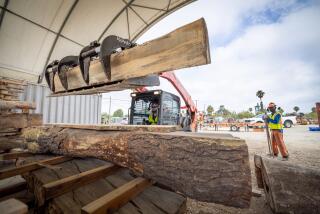Money in Trees : Whittier Businessmen Carve Out a Living, Tiki-Style
WHITTIER — When crews cut down a grove of century-old trees earlier this year in front of the Fred C. Nelles School, old-timers and horticulturists alike raised Cain. They protested that the trees were among the first planted by Quaker settlers who built the school in 1894, and should be saved from a street-widening project.
But progress won out, Whittier Boulevard was widened, and the trees were history.
What remains of the once-towering, silky oaks, ginkgoes and rubber trees will be loaded into a metal container today in Los Angeles Harbor and shipped to the Far East.
Destination: The snowy resort of Sapporo, Japan, where the trees--transformed by two Whittier men into life-size Tikis--will stand in a mountaintop restaurant bustling with skiers.
“We didn’t make the decision to cut (the trees) down,” said Robert Van Oosting, co-owner of Oceanic Arts in Whittier, “just how to carve them.”
Known Around the Globe
Van Oosting and his partner, LeRoy Schmaltz, have chipped out a name around the globe as traders of Polynesian merchandise. Their speciality is working with wood, reproducing South Seas artifacts from native war clubs and shields to Tikis. The men deal mostly with restaurants and hotels needing a tropical decor.
Carvings by Van Oosting and Schmaltz, both 50, are in hotels and eateries from Corsica to Atlantic City to Tahiti--and now Japan.
International exposure has done little to change the two Pico Rivera natives. They still feel more at home in their cluttered Whittier warehouse by the railroad tracks than the regal settings where many of their works are displayed. Partners since the late 1950s, the two men are still trying to complete their first sales catalogue.
Customers Invited to Drop Around
“When people call up and ask for a catalogue, I’m always a bit embarrassed because it isn’t finished,” said Van Oosting, a folksy sort who runs the business end of the import-export operation, while Schmaltz concentrates on the carvings. “If they’re interested, we just tell people to come by and see what we have.”
And they do. Earlier this year, a group of Japanese businessmen showed up to buy Polynesian pieces for their new Sapporo restaurant. Besides thatched mats, seashell lamps and cloth wall hangings, they wanted several large Tikis for the restaurant entrance. To fill the order, Schmaltz and his crew of five carvers hand-chiseled nine of the South Seas gods, using wood from trees cut down last February in front of Nelles school.
About a dozen trees in the grove were felled as part of a $720,000 widening of Whittier Boulevard by the state Department of Transportation. Despite efforts to save the trees--including a 70-foot-high rubber tree that was believed to be the largest of its kind in Los Angeles County--the trees came down.
Located only a few hundred feet from the widening project, Oceanic Arts purchased the trees so when the Japanese ordered the Tikis--including several six footers --the carvers had the materials ready to go.
40 to 50 Man-Hours
While Van Oosting would not discuss specifics, he said each Tiki represents about 40 to 50 man-hours, and sells for roughly $1,000, depending on size and detail.
Van Oosting and Schmaltz met in the mid 1950s while both attended Mount San Antonio College. They worked summers for longtime Whittier woodcarver Bob Carter, who eventually offered to sell his business. But the pair wanted their own Polynesian carving operation, so Van Oosting sold his prize Corvette, and he and Schmaltz journeyed to the South Seas where they spent 3 1/2 months roaming the back country of New Guinea and Tahiti. They studied the native art, particularly the woodwork, photographing carvings and talking to villagers.
Soon after the trip, they opened Oceanic Arts.
“What separates us from other carvers is our interest in authenticity,” said Schmaltz, who eventually studied art and anthropology at Cal State Los Angeles. “When we reproduce a piece, we try to be as true to the original as possible.”
Enjoys Weekly Check
While torn between his love of fine arts and carving, Schmaltz admits it’s nice to receive a weekly check. “I’ve known a lot of wonderful artists who worked their entire lives and received maybe a handful of commissions,” said Schmaltz, who paints after-hours. “That’s rough when you’re trying to raise a family and get ahead. Besides, a lot of people see our work, and that’s a nice feeling.”
Last year, Schmaltz and his crew carved a 30-foot-high totem pole out of a single redwood log. The work now stands at Walt Disney’s Epcot Center in Florida.
Closer to home, Schmaltz and Van Oosting are putting the final touches on a 24-foot-long outrigger canoe that will hang in the Tropics Restaurant in the Tropicana Hotel in Las Vegas. It took three carvers nearly 200 hours to finish the 1,000-pound, mahogany canoe.
“When people ask us what we do for a living, it’s kind of hard to explain, because we do a little of everything--importing, exporting and creating,” Van Oosting said. “I like to tell them, we’re simply chiselers.”
More to Read
Sign up for Essential California
The most important California stories and recommendations in your inbox every morning.
You may occasionally receive promotional content from the Los Angeles Times.










